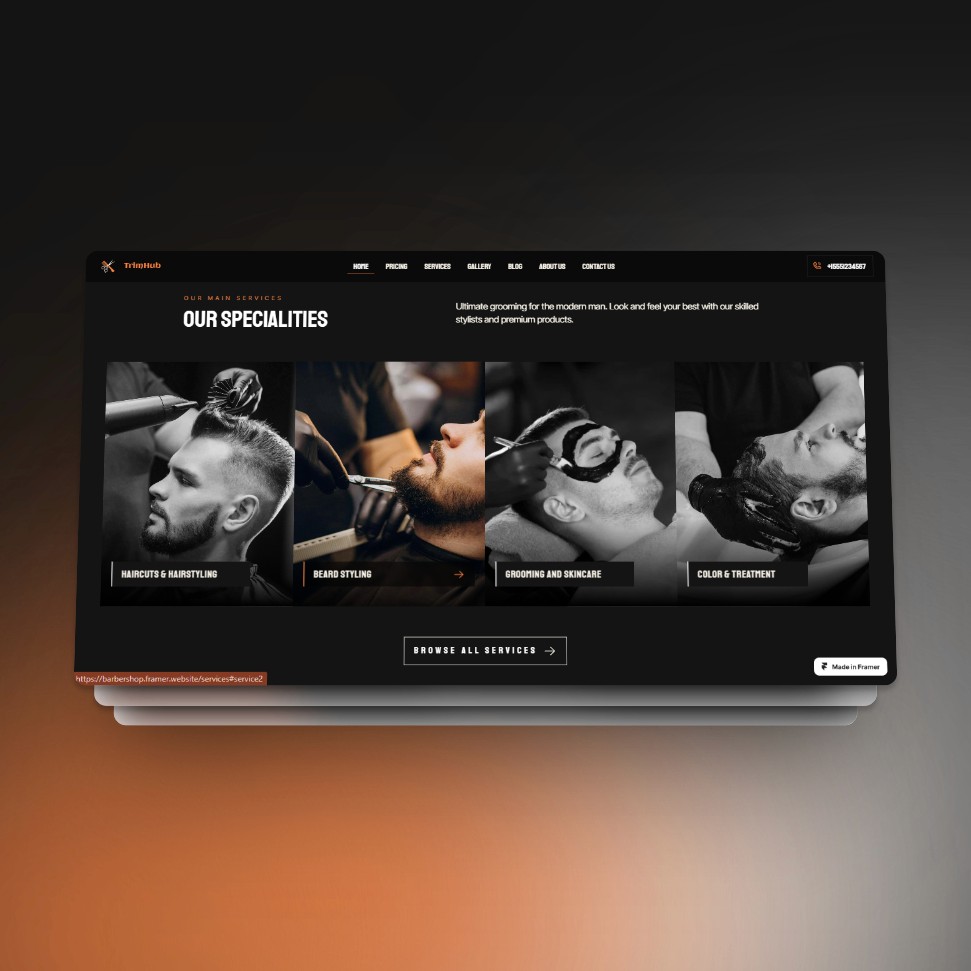Our Three Step Process
Our Three Step Process
The Startup That Thought a Logo Was a Business Plan

Our Three Step Process
The Startup That Thought a Logo Was a Business Plan

A two-person startup with big dreams and a tiny budget approached us with a simple request: “We need a logo that stands out.” At first, this seemed like a straightforward design task, but after digging deeper, we realized there was a much bigger issue—they had no clear business model, no target audience, and no real go-to-market strategy. They believed that a well-designed logo would somehow translate into a successful business. In reality, they were treating branding as a shortcut to growth rather than as a part of a well-thought-out strategy.
The Challenge
The biggest problem was their lack of foundational business planning. Their entire strategy revolved around the idea that once they had a logo, customers would magically appear. They hadn’t conducted any market research, they had no unique value proposition, and their product positioning was unclear. Their website was still in progress, their messaging was inconsistent, and their customer acquisition plan was non-existent. Simply put, they were trying to build a brand without first defining what that brand stood for.
Additionally, they wanted to appeal to "everyone," which is one of the most common mistakes early-stage startups make. By trying to target a broad, undefined audience, they were making it even harder to create a compelling identity.
Our Approach
Rather than just delivering a logo and walking away, we took a strategy-first approach to set them up for sustainable success. Our goal was to help them establish a clear brand identity, refine their business direction, and create a foundation that would support long-term growth.
1. Defining the Brand Strategy
We started by guiding them through a brand discovery process, which included:
Identifying their core mission, vision, and values to create a unique brand personality.
Conducting a competitive analysis to understand market gaps and positioning opportunities.
Refining their target audience to focus on a niche that would actually resonate with their product.
By the end of this phase, they had a clearly defined brand identity—something far beyond just a logo.
2. Crafting a Meaningful Visual Identity
Once the foundation was in place, we proceeded with designing their logo and brand visuals—but this time, with a strategic approach. We made sure the design aligned with their brand personality and target market.
We selected colors, typography, and design elements that reinforced their messaging.
We developed a brand style guide to maintain consistency across all platforms.
We helped them structure their website and marketing materials to ensure everything looked cohesive and professional.
3. Creating a Business & Marketing Plan
To address their lack of a go-to-market strategy, we worked with them to develop:
A clear messaging framework that highlighted their unique selling points.
A simple yet effective launch strategy, including a social media and email marketing plan.
A step-by-step roadmap for acquiring their first 500 customers.
This approach ensured that when they launched, they wouldn’t just have a good-looking brand—they would have a business that made sense.
The Results
Within just three months of implementing this structured approach, the startup saw tangible progress:
✅ A well-defined brand identity that resonated with their ideal audience.
✅ A professional, high-converting website that effectively communicated their value.
✅ A structured marketing plan that helped them gain their first 500 users.
✅ A business model that made sense, rather than just a fancy logo with no direction.
Key Takeaways
This case study proves that a logo is not a business plan. Many startups fall into the trap of thinking that branding alone will drive success, but branding must be backed by a solid business strategy. Without a clear vision, audience, and go-to-market plan, even the best-looking brand will struggle to gain traction.
The Challenge
The biggest problem was their lack of foundational business planning. Their entire strategy revolved around the idea that once they had a logo, customers would magically appear. They hadn’t conducted any market research, they had no unique value proposition, and their product positioning was unclear. Their website was still in progress, their messaging was inconsistent, and their customer acquisition plan was non-existent. Simply put, they were trying to build a brand without first defining what that brand stood for.
Additionally, they wanted to appeal to "everyone," which is one of the most common mistakes early-stage startups make. By trying to target a broad, undefined audience, they were making it even harder to create a compelling identity.
Our Approach
Rather than just delivering a logo and walking away, we took a strategy-first approach to set them up for sustainable success. Our goal was to help them establish a clear brand identity, refine their business direction, and create a foundation that would support long-term growth.
1. Defining the Brand Strategy
We started by guiding them through a brand discovery process, which included:
Identifying their core mission, vision, and values to create a unique brand personality.
Conducting a competitive analysis to understand market gaps and positioning opportunities.
Refining their target audience to focus on a niche that would actually resonate with their product.
By the end of this phase, they had a clearly defined brand identity—something far beyond just a logo.
2. Crafting a Meaningful Visual Identity
Once the foundation was in place, we proceeded with designing their logo and brand visuals—but this time, with a strategic approach. We made sure the design aligned with their brand personality and target market.
We selected colors, typography, and design elements that reinforced their messaging.
We developed a brand style guide to maintain consistency across all platforms.
We helped them structure their website and marketing materials to ensure everything looked cohesive and professional.
3. Creating a Business & Marketing Plan
To address their lack of a go-to-market strategy, we worked with them to develop:
A clear messaging framework that highlighted their unique selling points.
A simple yet effective launch strategy, including a social media and email marketing plan.
A step-by-step roadmap for acquiring their first 500 customers.
This approach ensured that when they launched, they wouldn’t just have a good-looking brand—they would have a business that made sense.
The Results
Within just three months of implementing this structured approach, the startup saw tangible progress:
✅ A well-defined brand identity that resonated with their ideal audience.
✅ A professional, high-converting website that effectively communicated their value.
✅ A structured marketing plan that helped them gain their first 500 users.
✅ A business model that made sense, rather than just a fancy logo with no direction.
Key Takeaways
This case study proves that a logo is not a business plan. Many startups fall into the trap of thinking that branding alone will drive success, but branding must be backed by a solid business strategy. Without a clear vision, audience, and go-to-market plan, even the best-looking brand will struggle to gain traction.
A two-person startup with big dreams and a tiny budget approached us with a simple request: “We need a logo that stands out.” At first, this seemed like a straightforward design task, but after digging deeper, we realized there was a much bigger issue—they had no clear business model, no target audience, and no real go-to-market strategy. They believed that a well-designed logo would somehow translate into a successful business. In reality, they were treating branding as a shortcut to growth rather than as a part of a well-thought-out strategy.
The Challenge
The biggest problem was their lack of foundational business planning. Their entire strategy revolved around the idea that once they had a logo, customers would magically appear. They hadn’t conducted any market research, they had no unique value proposition, and their product positioning was unclear. Their website was still in progress, their messaging was inconsistent, and their customer acquisition plan was non-existent. Simply put, they were trying to build a brand without first defining what that brand stood for.
Additionally, they wanted to appeal to "everyone," which is one of the most common mistakes early-stage startups make. By trying to target a broad, undefined audience, they were making it even harder to create a compelling identity.
Our Approach
Rather than just delivering a logo and walking away, we took a strategy-first approach to set them up for sustainable success. Our goal was to help them establish a clear brand identity, refine their business direction, and create a foundation that would support long-term growth.
1. Defining the Brand Strategy
We started by guiding them through a brand discovery process, which included:
Identifying their core mission, vision, and values to create a unique brand personality.
Conducting a competitive analysis to understand market gaps and positioning opportunities.
Refining their target audience to focus on a niche that would actually resonate with their product.
By the end of this phase, they had a clearly defined brand identity—something far beyond just a logo.
2. Crafting a Meaningful Visual Identity
Once the foundation was in place, we proceeded with designing their logo and brand visuals—but this time, with a strategic approach. We made sure the design aligned with their brand personality and target market.
We selected colors, typography, and design elements that reinforced their messaging.
We developed a brand style guide to maintain consistency across all platforms.
We helped them structure their website and marketing materials to ensure everything looked cohesive and professional.
3. Creating a Business & Marketing Plan
To address their lack of a go-to-market strategy, we worked with them to develop:
A clear messaging framework that highlighted their unique selling points.
A simple yet effective launch strategy, including a social media and email marketing plan.
A step-by-step roadmap for acquiring their first 500 customers.
This approach ensured that when they launched, they wouldn’t just have a good-looking brand—they would have a business that made sense.
The Results
Within just three months of implementing this structured approach, the startup saw tangible progress:
✅ A well-defined brand identity that resonated with their ideal audience.
✅ A professional, high-converting website that effectively communicated their value.
✅ A structured marketing plan that helped them gain their first 500 users.
✅ A business model that made sense, rather than just a fancy logo with no direction.
Key Takeaways
This case study proves that a logo is not a business plan. Many startups fall into the trap of thinking that branding alone will drive success, but branding must be backed by a solid business strategy. Without a clear vision, audience, and go-to-market plan, even the best-looking brand will struggle to gain traction.








Other Projects
Other Case Studies
Check our other project case studies with detailed explanations
Other Projects
Other Case Studies
Check our other project case studies with detailed explanations
Other Projects
Other Case Studies
Check our other project case studies with detailed explanations


